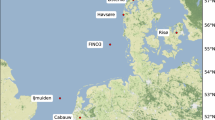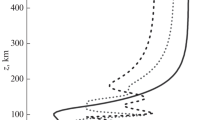Abstract
The influence of the averaged vertical wind on the transport of stratospheric aerosol has been analyzed with the use of the database of the GCM UKMO assimilated model for 1993–2006. With the problem regarding the action of a permanent source of particles near the stratopause taken as an example, it is shown that if the action of the averaged vertical component is taken into account along with the gravitational sedimentation and turbulent diffusion, the standard vertical profiles of the relative concentration of particles change cardinally. The results are presented for the levitation heights of particles of different densities and sizes in the stratosphere under the action of gravity and wind pressure.
Similar content being viewed by others
References
G. P. Brasseur and S. Solomon, Aeronomy of the Middle Atmosphere, 3rd ed. (Springer, Dordrecht, 2005).
M. Gerding, G. Baumgarten, U. Blum, J. P. Thaye, K.-H. Fricke, R. Neuber, and J. Fiedler, “Observation of an Unusual Mid-Stratospheric Aerosol Layer in the Arctic: Possible Sources and Implications for Polar Vortex Dynamics,” Ann. Geophys. 21, 1057–1069 (2003).
H.-J. Jost, K. Drdla, A. Stohl, L. Pfister, M. Loewenstein, J. P. Lopez, P. K. Hudson, D. M. Murphy, D. J. Cziczo, M. Fromm, T. P. Bui, Dean-J. Day, C. Gerbig, M. J. Mahoney, E. C. Richard, N. Spichtinger, J. V. Pittman, E. M. Weinstock, J. C. Wilson, and I. Xueref, “In-Situ Observations of Mid-Latitude Forest Fire Plumes Deep in the Stratosphere,” Geophys. Res. Lett. 31, L11101 (2004), doi: 10.1029/2003GL019253.
B. Kürcher, “Properties of Subvisible Cirrus Clouds Formed by Homogeneous Freezing,” Atmos. Chem. Phys. 2, 160–170 (2002).
B. P. Luo, Th. Peter, H. Wernli, S. Fueglistaler, M. Wirth, C. Kiemle, H. Flentje, V. A. Yushkov, V. Khattatov, V. Rudakov, A. Thomas, S. Borrmann, G. Toci, P. Mazzinghi, J. Beuermann, C. Schiller, F. Cairo, Di Don-G. Francesco, A. Adriani, C. M. Volk, J. Strom, K. Noone, V. Mitev, R. A. MacKenzie, K. S. Carslaw, T. Trautmann, V. Santacesaria, and L. Stefanutti, “Ultrathin Tropical Tropopause Clouds (UTTCs): II. Stabilization Mechanisms,” Atmos. Chem. Phys. 3, 1093–1100 (2003).
J.-B. Renard, C. Brogniez, G. Berthet, Q. Bourgeois, B. Gaubicher, M. Chartier, J.-Y. Balois, C. Verwaerde, F. Auriol, P. Francois, D. Daugeron, and C. Engrand, “Vertical Distribution of the Different Types of Aerosols in the Stratosphere: Detection of Solid Particles and Analysis of Their Spatial Variability,” J. Geophys. Res. 113, D21303 (2008), Doi: 10.1029/2008JD010150.
M. Wainwright, S. Alharbi, and N. C. Wickramasinghe, “How Do Microorganisms Reach the Stratosphere?” Int. J. Astrobiol. 5, 13–15 (2006).
D. Koch and J. Hansen, “Distant Origins of Arctic Black Carbon: A Goddard Institute for Space Studies Model Experiment,” J. Geophys. Res. 110, D04204 (2005), doi: 10.1029/2004JD005296.
D. W. Fahey, R. S. Gao, K. S. Carslaw, J. Kettleborough, P. J. Popp, M. J. Northway, J. C. Holecek, S. C. Ciciora, R. J. McLaughlin, T. L. Thompson, R. H. Winkler, D. G. Baumgardner, B. Gandrud, P. O. Wennberg, S. Dhaniyala, K. McKinney, Th. Peter, R. J. Salawitch, T. P. Bui, J. W. Elkins, C. R. Webster, E. L. Atlas, H. Jost, J. C. Wilson, R. L. Herman, A. Kleinbohl, and M. von Kohnig, “The Detection of Large HNO3-Containing Particles in the Winter Arctic Stratosphere,” Science 291(5506), 1026–1031 (2001).
S. A. Beresnev and V. I. Gryazin, “Vertical Wind Transfer of Aerosols in Stratosphere,” Atmos. Oceanic Opt. 20, 537–543 (2007).
S. A. Beresnev, V. I. Gryazin, and K. G. Gribanov, “Climatology of Vertical Wind in Middle Atmosphere,” Atmos. Oceanic Opt. 21, 516–522 (2008).
C. E. Junge, C. W. Chagnon, and J. E. Manson, “Stratospheric Aerosols,” J. Meteorol. 18, 81–108 (1961).
R. C. Whitten, O. B. Toon, and R. P. Turco, “The Stratospheric Sulfate Aerosol Layer: Process, Models, Observations, and Simulations,” Pure Appl. Geophys. 118, 86–127 (1980).
A. S. Koziol and J. Pudykiewicz, “High-Resolution Modeling of Size-Resolved Stratospheric Aerosol,” J. Atmos. Sci. 55, 3127–3147 (1998).
C. Li and G. J. Boer, “The Continuity Equation for the Stratospheric Aerosol and Its Characteristic Curves,” J. Atmos. Sci. 57, 442–451 (2000).
D. Fussen, P. Vanhellemont, and C. Bingen, “Evolution of Stratospheric Aerosols in the Post-Pinatubo Period Measured by Solar Occultation,” Atmos. Environ. 35, 5067–5078 (2001).
G. Panegrossi, D. Fua, and G. Fiocco, “A 1-D Model of the Formation and Evolution of Polar Stratospheric Clouds,” J. Atmos. Chem. 23, 5–35 (1996).
H. Flentje, A. Dürnbrack, F. Fix, F. Meister, H. Schmid, S. Föglistaler, B. Luo, and Th. Peter, “Denitrification Inside the Stratospheric Vortex in the Winter of 1999–2000 by Sedimentation of Large Nitric Acid Trihydrate Particles,” J. Geophys. Res. 107, 4314 (2002), doi:10.1029/2001JD001015.
B. Kürcher and J. Ström, “The Roles of Dynamical Variability and Aerosols in Cirrus Cloud Formation,” Atmos. Chem. Phys. 3, 823–838 (2003).
U. Lohmann and B. Kürcher, “First Interactive Simulations of Cirrus Clouds Formed by Homogeneous Freezing in the ECHAM General Circulation Model,” J. Geophys. Res. 107, No. 10 (2002), doi: 10.1029/2001JD000767.
P. Spichtinger and K. M. Gierens, “Modelling of Cirrus Clouds — Part 1b: Structuring Cirrus Clouds by Dynamics,” Atmos. Chem. Phys. 9, 707–719 (2009).
M. M. R. Williams and S. K. Loyalka, Aerosol Science; Theory and Practice: with Special Applications to the Nuclear Industry (Pergamon, Oxford, 1991).
A. E. Aloyan, Simulation of Dynamics and Kinetics of Gas Impurities and Aerosols in Atmosphere (Nauka, Moscow, 2008) [in Russian].
P. Raist, Introduction to Aerosol Science (Macmillan, New York, 1984; Mir, Moscow, 1987).
F. Kasten, “Falling Speed of Aerosol Particles,” J. Appl. Meteorol. 7, 944–947 (1968).
G. P. Anderson, S. A. Clough, F. X. Neizys, J. H. Chetwynd, and E. P. Shettle, “AFGL Atmospheric Constituent Profiles (0–120 km),” Air Force Geophysics Laboratory (USA) AFGL-TR-86-0110, Environment Research Paper No. 954 (1986).
A. Guha, “Transport and Deposition of Particles in Turbulent and Laminar Flow,” Ann. Rev. Fluid Mech. 40, 311–341 (2008).
K. N. Volkov and V. N. Emel’yanov, Flows of Gas with Particles (Fizmatlit, Moscow, 2008) [in Russian].
J. B. Liley, “Analytic Solution of a One-Dimensional Equation for Aerosol and Gas Dispersion in the Stratosphere,” J. Atmos. Sci. 52, 3283–3288 (1995).
D. N. Rao, M. V. Ratnam, T. N. Rao, and S. V. B. Rao, “Seasonal Variation of Vertical Eddy Diffusivity in the Troposphere, Lower Stratosphere and Mesosphere over a Tropical Station,” Ann. Geophys. 19, 975–984 (2001).
R. Wilson, “Turbulent Diffusivity in the Free Atmosphere Inferred from MST Radar Measurements: A Review,” Ann. Geophys. 22, 3869–3887 (2004).
S. A. Beresnev, F. D. Kovalev, L. B. Kochneva, V. A. Runkov, P. E. Suetin, and A. A. Cheremisin, “On the Possibility of Particle’s Photophoretic Levitation in the Stratosphere,” Atmos. Oceanic Opt. 16, 52–57 (2003).
S. A. Beresnev, L. B. Kochneva, P. E. Suetin, V. I. Zakharov, and K. G. Gribanov, “Photophorese of Atmospheric Aerosols in Thermal Emission Field of the Earth,” Atmos. Oceanic Opt. 16, 470–477 (2003).
E. Kalnay, M. Kanamitsu, R. Kistler, W. Collins, D. Deaven, L. Gandin, M. Iredell, S. Saha, G. White, J. Woollen, Y. Zhu, A. Leetmaa, R. Reynolds, M. Chelliah, W. Ebisuzaki, W. Higgins, J. Janowiak, K. C. Mo, C. Ropelewski, J. Wang, R. Jenne, and D. Joseph, “The NCEP/NCAR 40-Year Reanalysis Project,” Bull. Amer. Meteorol. Soc. 77, 437–471 (1996).
Author information
Authors and Affiliations
Additional information
Original Russian Text © Gryazin, Beresnev, 2010, published in Optica Atmosfery i Okeana.
Rights and permissions
About this article
Cite this article
Gryazin, V.I., Beresnev, S.A. On the consideration of the averaged vertical wind in problems of stratospheric aerosol transport. Atmos Ocean Opt 23, 174–180 (2010). https://doi.org/10.1134/S1024856010030036
Received:
Published:
Issue Date:
DOI: https://doi.org/10.1134/S1024856010030036




